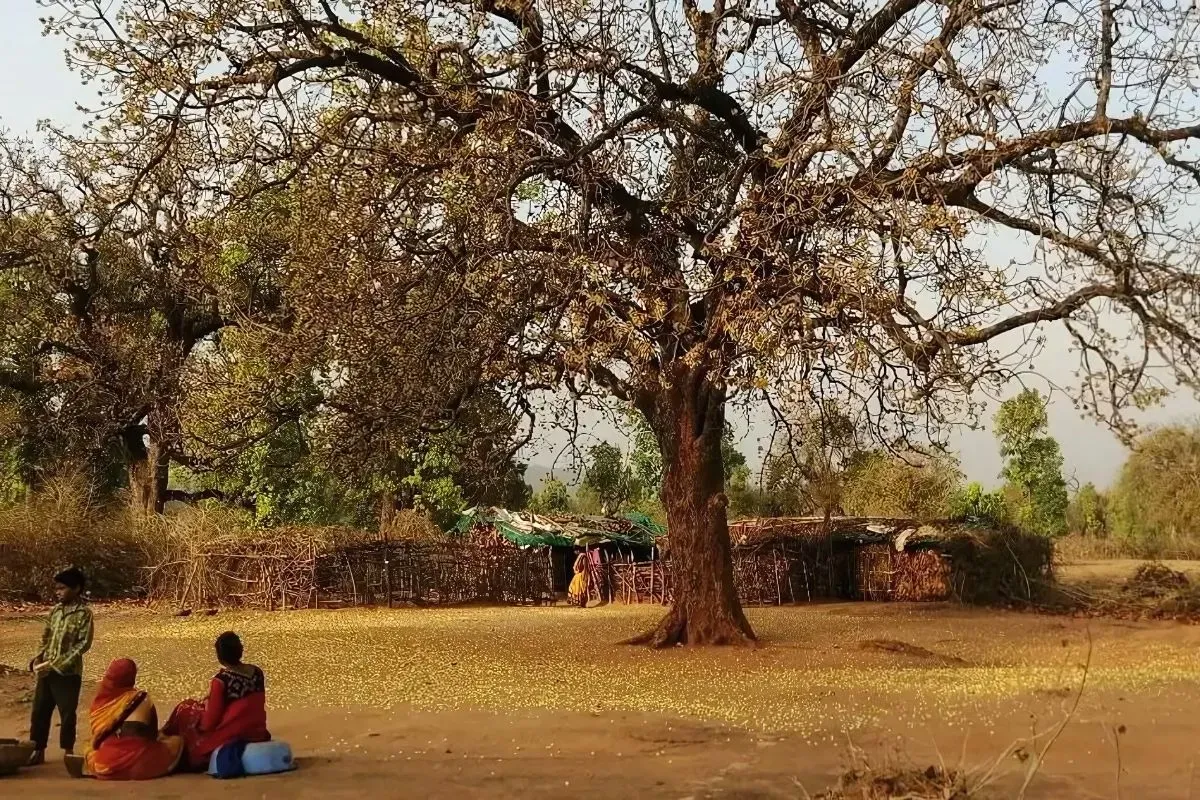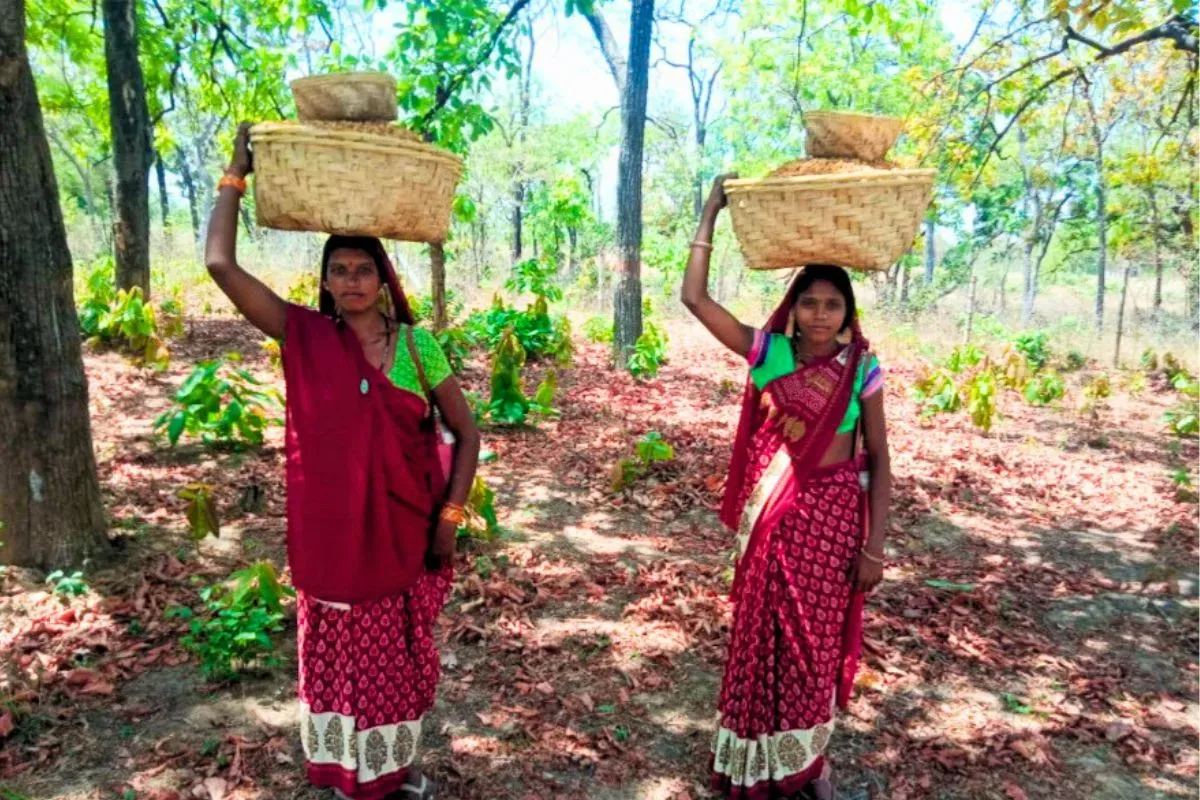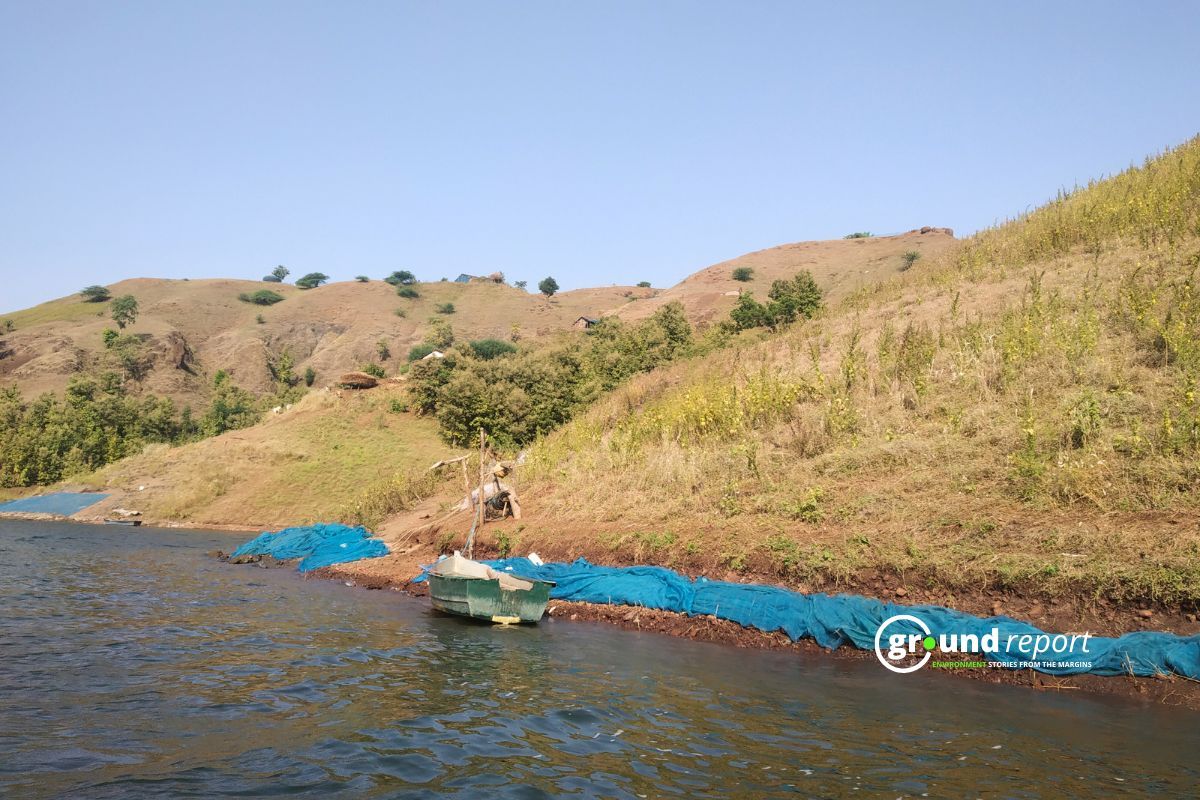Read in Hindi | For the indigenous communities living near the forests of Madhya Pradesh, the period from March to May is usually filled with enthusiasm. This is the time when they collect minor forest produce such as mahua flowers, chironji, and tendu leaves from the forests, which helps them in their sustenance. However, this year, indigenous people are worried.
Shivcharan Baiga from Chilhari village in Manpur block of Umaria district says, “Every year, I collect around 4.5 to 5 quintals of mahua, but this time I couldn’t. He blames irregular rainfall and hailstorms that damaged the mahua flowers,. “I could only gather about 1.5 to 2 quintals,” he laments.
Baiga further adds that the damage isn’t limited to Mahua alone. There has also been a decline in other minor forest produce, particularly tendu leaves. In previous years, people living near the forests used to earn around 8 to 9 thousand rupees annually by selling tendu leaves in the local market. However, this year they hope to earn only 2 to 3 thousand rupees.
Dependency of Madhya Pradesh’s Indigenous People on Mahua
Madhya Pradesh is the state with the highest population of Scheduled Tribes in the country. Mahua trees (Madhuca longifolia), found abundantly in Madhya Pradesh along with Odisha, Chhattisgarh, and Andhra Pradesh, are significant Minor Forest Produce (MFP). According to the Tribal Cooperative Marketing Development Federation of India (TRIFED), around 75% of tribal families in Madhya Pradesh, Odisha, and Andhra Pradesh are involved in collecting mahua flowers.
According to the Madhya Pradesh Minor Forest Produce Federation, approximately 32,356 quintals of mahua were produced in Madhya Pradesh last year. Fifty per cent of this production occurs in Alirajpur, Jhabua, Umaria, Sidhi, Singrauli, Dindori, Mandla, Shahdol, and Betul districts. However, indigenous people in these districts do not seem to have the usual enthusiasm this year. The irregular weather affecting forest produce is having an impact on the livelihoods of forest dwellers.
How is Changing Climate Affecting Forest Produce?
According to the Indian Meteorological Department, many parts of the country, including Madhya Pradesh, have experienced irregular rainfall and hailstorms due to the Western Disturbance in and around northern Afghanistan in recent days. This has severely affected more than 15 districts of the state. Crops like chickpeas, mustard, and wheat have suffered losses ranging from 20 to 30 percent in these districts, impacting forest produce as well.
Scientist Seema Yadav, who has studied the impact of climate change on non-timber forest products in two forest areas of Hoshangabad and Mandla districts of Madhya Pradesh, says,
“In recent years, as climate change has led to irregular rainfall and hail storms in the state, other weather patterns have also become irregular. Similarly, changes are also occurring in the production of other forest produce along with mahua. Due to irregular weather, clouds gather in the sky even outside the monsoon season, which prevents mahua flowers from ripening properly, directly affecting mahua production.”
Scientists say that the changing climate is affecting the phenology of mahua. Due to this, instead of blooming in mid-March as it used to, mahua flowers are now blooming and falling in mid-February. According to research on the impact of climate change in eastern Madhya Pradesh, there has been a 25 per cent decrease in mahua production.
What is Happening to the Forest Dwellers?
Another forest dweller, Shivcharan’s wife Sukhera Bai, 37, says,
“We thought of collecting mahua flowers this year and selling them at good prices to marry off our daughters. But it couldn’t happen because irregular weather has ruined everything.”
Rupabai from Paras village in Manpur block of Umaria district, says, “Since I was little, I have been collecting mahua flowers from the jungle with my family. I leave for the jungle at 5 in the morning and gather mahua until noon. This is how I sustain my family for six months. My daughter, sons, and husband accompany me in the jungle.”
Rupabai’s husband Phoolsingh, (44) says, “I inherited 40 trees from my father. I have distributed 10 trees to each of our three sons, and I have 10 trees left. We collect mahua flowers from these trees with my wife and daughter throughout the year. This is how we manage our expenses. We get 40 rupees per kilogram of mahua. Every year we collect 450 to 500 kilos. But this year everything has been ruined. We could only gather up to 150 kilos.”
He shares the situation is the same with tendu leaves. “Surviving on the three to four kilograms of ration provided by the government is difficult,” he says.
Last year, 1000 quintals of Mahua were sent from Umaria to London. Deputy Field Director of Bandhavgarh Tiger Reserve, P.K. Verma believes that forest produce is also being affected due to the changing climate. To prevent this, awareness and training are necessary. According to him, tribal people take the help of fire to clear the ground under Mahua trees to collect Mahua flowers, and due to dry weather, this fire devastatingly spreads in the forest. This fire not only harms biodiversity and wildlife but also increases carbon emissions. Because of this, not only the biodiversity of the forest is being damaged but also the production of forest produce is being affected.
Verma further says,
“We are organizing training programs to constantly educate the rural population. We are encouraging them to use the Green Net for Mahua collection. Last year, traders from London bought 2000 quintals of Mahua in the state, and 1000 quintals were sent from Umaria district. This time, there is a possibility of double demand.”
On the other hand, the tribal people of Umaria district are alleging the Forest Department of selling Mahua to traders from London at Rs 110 per quintal while giving them only Rs 50 per quintal.
Responding to the villagers, senior forest officer Verma says,
“According to the Ministry of Tribal Affairs, the minimum support price for Mahua seeds is Rs. 45 and for Mahua flowers, it is Rs. 50 per kilogram. We are buying at the prices set by the government.”
Mahua Collection through Green Net
In 2020, to control incidents of fire in the forests of the state and for the conservation of biodiversity, the Environmental Services Improvement Project was started in the Betul district. Under this project, the Mahua collection is being promoted through the Green Net.
The Green Net is tied two to three feet above the ground under the tree. Mahua flowers fall on the net, which can be easily collected by the villagers. Earlier, these people had to pick flowers from the ground, which would get spoiled in the soil if the weather was bad.
Chief Secretary J N Kansautiya says,
“This initiative has reduced forest fires to a considerable extent and made rural people aware of biodiversity conservation, thus reducing the expenses incurred in Mahua collection.”
According to Kansautiya, the project’s area has been expanded to Khandwa, Umaria, Alirajpur, South Betul, and West Mandla districts. Green nets, food-grade bags, and other items worth Rs 60 lakh have been purchased by district unions and distributed among the villagers. Additionally, more than 4000 beneficiaries have been trained.
Pawan Yadav of Kupwa village in Betul district says that in 2020, the Forest Department asked them to use Green Net for Mahua collection. During this time, forest department officials also provided training, during which they understood how much damage is being caused to plants due to forest fires.
Adivasis and local healer Vasudev Khan of Khatpura village in Betul district say that earlier their whole family would reach the forest before dawn and spend the whole day collecting flowers. Sometimes they had to skip meals, but now, with the use of the Green Net, they are reducing their hard work over time.
Women have also benefited from the Green Net. Phoolanbai of Khatpura village says,
“Earlier, I used to bend in the sun all day collecting flowers, which would cause pain in my back. Now, after finishing the household chores, I go to the forest and easily collect the fallen flowers from the net.”
The District Forest Officer of Betul, Vijayanantham TR, believes that the income of tribal communities’ families has increased due to the Green Net. Also, it is helping to make the process of selecting Mahua flowers environmentally friendly.
J N Kansautiya says that in 2021, under the Forest Department’s resource development, 14.17 lakh plants were planted in 1889 hectares, 45.65 lakh plants in 6087 hectares in 2020, and 28.83 lakh plants in 3844 hectares in 2023. These plants mainly include minor forest produce species such as Mahua, Amla, Henna, Baheda, Karanj, Kusum, Neem, Katha, Reetha, Bhilawa, Bel, and Aonla, etc. The aim is to protect the livelihoods of forest-dependent communities from climate change.
Will afforestation solve the problem of climate change?
Dr RK Jayaswal, Principal Scientist at the Fruit Research Center, Bhopal, says that we need extensive research to understand how much climate change is affecting the forests of the state, or which plant species found in forests are being affected by climate change and which plant species have adapted or attempted to adapt to climate change. Only then can we find a solution to this problem.
Dr. Jayaswal further says “Research has started to assess the impact of climate change on trees, plants, and vegetation in the permanent reserve monitoring plots located in Kanha National Park in the state, spread over approximately 10 hectares. However, this research is still in its initial stages. Until the results of this research are available, we will have to rely on controlling forest fires and afforestation as options.”
Keep Reading
Indore Reviving Historic Lakes to Combat Water Crisis, Hurdles Remain
Government’s claim to promote organic farming in MP- fact or fiction?
Follow Ground Report for Environmental News From India. Connect with us on Facebook, Twitter, Koo App, Instagram, Whatsapp and YouTube. Write us on GReport2018@gmail.com and subscribe our free newsletter.
Don’t forget to check out our climate glossary, it helps in learning difficult environmental terms in simple language.












